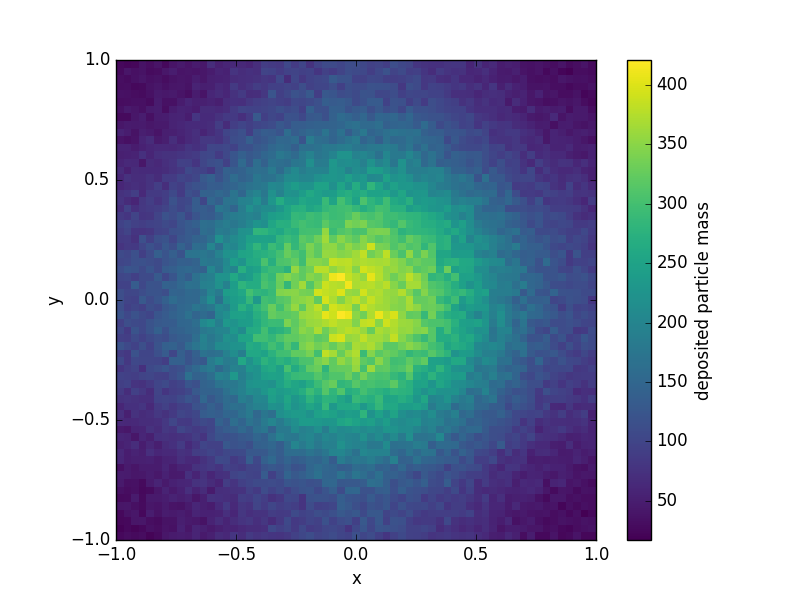A Generic Particle+Grid Interface
Project description
GPGI
A Generic Particle + Grid data Interface
This small Python library implements fundamental grid deposition algorithms to analyse (rectilinear) grid + particle datasets, with an emphasize on performance. Core algorithms are implemented as Cython extensions.
Installation
python -m pip install --upgrade pip
python -m pip install gpgi
Supported applications
A rectilinear grid is defined as 1D arrays representing cell left edges in each directions. Note that the last point of such an array is interpreted as the right edge of the rightmost cell, so for instance, a 1D grid containing 100 cells is defined by 101 edges.
Particles are defined as points that live on the grid.
Deposition is the action of going from particule description to a grid description of a field. It is useful to analyze, compare and combine simulation data that exists in a combination of the two formalism. This process is not reversible as it degrades information.
For instance, here's a simple overlay of a particle set (red dots) against a background that represents the deposited particle count.

This example illustrates the simplest possible deposition method "Particle in Cell", in which each particle contributes only to the cell that contains it.
More refined methods are also available.
Supported deposition methods
| method name | abreviated name | order | availability |
|---|---|---|---|
| Particle in Cell | PIC | 0 | ✅ |
| Cloud in Cell | CIC | 1 | ❌ |
| Triangular Shaped Cloud | TSC | 2 | ✅ |
Supported boundary conditions
With CIC and TSC deposition, particles contribute to cells neighbouring the one that contains them. This means that particles that live in the outermost layer of the domain are partly smoothed out of it.
In a future version, I intend to allow special treatments for these lost bits, in particular, periodic boundaries.
Supported geometries
| geometry name | axes order | availability |
|---|---|---|
| cartesian | x, y, z | ✅ |
| polar | radius, z, azimuth | ✅ |
| cylindrical | radius, azimuth, z | ✅ |
| spherical | radius, colatitude, azimuth | ✅ |
| equatorial | radius, azimuth, colatitude | ❌ |
Time complexity
An important step in perfoming deposition is to associate particle indices to cell indices. This step is called "particle indexing". In directions where the grid is uniformly stepped (if any), indexing a particle is an O(1) operation. In the more general case, indexing is performed by bisection, which is a O(log(nx))) operation (where nx represents the number of cells in the direction of interest).
Usage
The API consists in a load function, which returns a Dataset object.
Load data
import numpy as np
import gpgi
nx = ny = 64
nparticles = 600_000
prng = np.random.RandomState(0)
ds = gpgi.load(
geometry="cartesian",
grid={
"cell_edges": {
"x": np.linspace(-1, 1, nx),
"y": np.linspace(-1, 1, ny),
},
},
particles={
"coordinates": {
"x": 2 * (prng.normal(0.5, 0.25, nparticles) % 1 - 0.5),
"y": 2 * (prng.normal(0.5, 0.25, nparticles) % 1 - 0.5),
},
"fields": {
"mass": np.ones(nparticles),
},
},
)
The Dataset object holds a grid and a particle attribute,
which both hold a fields attribute for accessing their data.
But more importantly, the Dataset has a deposit method to
translate particle fields to the grid formalism.
Deposit Particle fields on the grid
particle_mass = ds.deposit("mass", method="particle_in_cell") # or "pic" for shorts
Visualize
In this example we'll use matplotlib for rendering, but note that matplotlib is not a dependency to gpgi
import matplotlib.pyplot as plt
fig, ax = plt.subplots()
ax.set(aspect=1, xlabel="x", ylabel="y")
im = ax.pcolormesh(
"x",
"y",
particle_mass.T,
data=ds.grid.cell_edges,
cmap="viridis",
)
fig.colorbar(im, ax=ax)

The example script given here takes about a second (top to bottom).
Project details
Release history Release notifications | RSS feed
Download files
Download the file for your platform. If you're not sure which to choose, learn more about installing packages.















